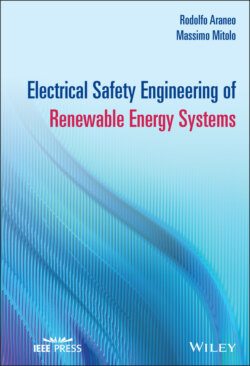Читать книгу Electrical Safety Engineering of Renewable Energy Systems - Rodolfo Araneo - Страница 20
1.6 Ground-Potential and Ground-Resistance
ОглавлениеA ground electrode is a conductive part, embedded in the soil or in another conductive medium (e.g., concrete), which is in electrical contact with the earth [22].
A connection to the ground can also be made through metalwork not forming part of the electrical installation, such as structural steelwork, metal, water supply pipes, or other buried metalwork. Such metalwork, however, should not be relied upon as an electrode, as it could be removed or replaced without any warning to users. The safety purpose of ground-electrodes is to effectively dissipate fault-currents into the soil.
To illustrate the relationship between ground-potentials, ground-resistances, and ground-currents, we study a hemispherical electrode, as this will allow the understanding of the performance of electrodes of different geometry.
We consider a hemisphere of radius r0 embedded in a boundless and uniform soil of resistivity ρ, buried at a sufficient distance from a receiving electrode, and that the ground-current i leaking from this electrode flows radially into the soil (Figure 1.8).
Figure 1.8 Hemispherical ground-electrode.
The current density J→, identified as a vector quantity, through a surface S in the soil of infinitesimal thickness dl, r from the center of the hemisphere, is related to the uniform leakage current i through the flux operator expressed in Eq. 1.5.
(1.5)
Equation 1.5 yields:
(1.6)
where r^ is the unit vector in the radial direction.
The electric field E→at any distance r from the center of the hemisphere can be determined as:
(1.7)
The ground-potential on the soil surface at any distance r from the center of the hemisphere, which is taken zero at infinity, is:
(1.8)
The ground-potential V(r) features a hyperbolic distribution through the soil, with the coordinate axes as asymptotes (Figure 1.9 ).
Figure 1.9 Hyperbolic distribution of the ground-potential V(r) over the soil.
The equipotential surfaces are hemispheres, including the actual surface of the electrode. Points belonging to the same equipotential surface have equal potential both on the surface and deep in the soil. Current lines are perpendicular to such surfaces.
The ground-potential rise on the surface of the hemisphere, that is, the potential at the distance r0 from its center, is
(1.9)
We define the resistance RG of the hemisphere-electrode to earth (from now on the ground-resistance) as the ratio of the ground-potential rise VG to the leakage current i (Eq. 1.10).
(1.10)
The ground-resistance of a ground-electrode can be seen as an equivalent one-port (Figure 1.10): one terminal of the one-port is the metal connection to the electrode (generally named grounding electrode conductor in codes and standards), whereas the other terminal represents a point at zero potential (i.e., a point at sufficient distance from the electrode where the potential is negligible).
Figure 1.10 Electrode ground-resistance as an equivalent one-port.
The ground symbol (from IEC 60417 “Graphical symbols for use on equipment,” symbol 5017) does not represent the soil, but a point at sufficient distance from the electrode where the surface potential is negligible.
From the graph of the ground potential of Figure 1.9, it can be observed that the radius r0 of the hemisphere identifies the point from where the hyperbolic distribution starts. For a given hemisphere, different values of the product ρi determine different hyperbolae, whose distance for the horizontal axis depends on the soil resistivity and the fault-current.
The rate-of-change of the potential with the distance r from the hemisphere (i.e., the potential gradient) is defined in Eq. 1.11.
(1.11)
which shows that the maximum variation of the ground potential occurs in proximity of the hemispherical electrode (i.e. r ≈ ro).
